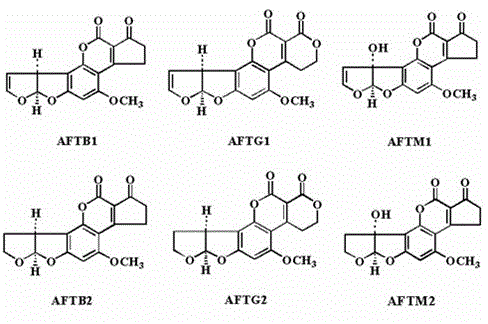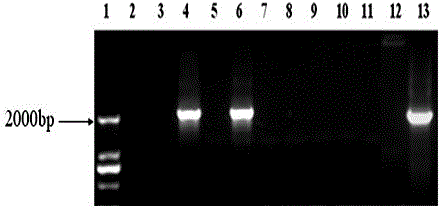Gene for coding aflatoxin degradation enzyme and method for obtaining high-efficiency aflatoxin degradation enzyme
A kind of aflatoxin and degrading enzyme technology, applied in feed, biotechnology application or agriculture, food field, can solve the problems of low degradation efficiency, harsh use conditions, low yield and activity of natural enzymes, etc.
- Summary
- Abstract
- Description
- Claims
- Application Information
AI Technical Summary
Problems solved by technology
Method used
Image
Examples
Embodiment 1
[0029] The optimized aflatoxin degrading enzyme gene of embodiment 1 ( Opt-ADTZ )
[0030] Search for the aflatoxin degrading enzyme gene (GeneBank No. AY941095.1) on NCBI, and optimize the codons to obtain the optimized aflatoxin degrading enzyme gene ( Opt-ADTZ ), the nucleotide sequence of which is shown in SEQ ID NO.1, and the sequence similarity between the optimized gene and the original gene is 78%. After the synthesis of Opt-ADTZ, it was cloned into the pUC19 vector to obtain pUC19-Opt-ADTZ.
Embodiment 2
[0031] Example 2 Construction of aflatoxin degrading enzyme expression vector pCold-II-Opt-ADTZ
[0032] (1) Extraction of plasmid
[0033] Take 2 Erlenmeyer flasks containing 20mL LB (tryptone 10g / L, yeast extract 5g / L, NaCl 10g / L, ampicillin 30mg / L) medium, and put pUC19-Opt-ADTZ, pCold-II A single colony of the plasmid was added to the culture medium, cultured overnight at 37°C and 220 rpm, and the plasmid was extracted according to the SDS lysis method. After the plasmid extraction is completed, mark it and put it in a 4°C refrigerator for use in the next step.
[0034] (2) PCR amplification Opt-ADTZ , Opt-ADTZ Digestion with pCold-II
[0035] PCR amplification reaction system: plasmid (pUC19-Opt-ADTZ) 1 μL, 10×buffer 5 μL, dNTPs 4 μL, Opt-ADTZ upstream primer 1 μL, Opt-ADTZ downstream primer 1 μL, Taq DNA polymerase 1 μL, add ddH 2 0 to 50 μL.
[0036] Opt-ADTZ upstream primer is 5'-C GCATA TGC ATGGCGACCACCACC-3',
[0037] Opt-ADTZ downstream primer is 5'-AT ...
Embodiment 3
[0047] Example 3 Expression and purification of aflatoxin degrading enzyme
[0048](1) Optimization of induction conditions
[0049] The concentration of the bacterial solution before induction, the concentration of the inducer tetracycline and IPTG, the induction expression temperature, and the induction time were optimized
[0050] The pCold-II-Opt-ADTZ plasmid in Escherichia coli DH5α was extracted, and the extracted plasmid was transformed into BL21-PG-Tf2 competent medium. Activate the expressing bacteria containing the target gene in a 20 mL LB medium flask containing 30 mg / L ampicillin at 37 °C and 220 rpm for 16 hours, take the activated bacterial liquid and inoculate it in 500 mL LB medium at an inoculation amount of 2.5%. Choose different induction conditions to induce expression. After induction of expression, the bacteria were collected, and the expression of the target protein was detected by SDS-PAGE to determine the optimal induction conditions. Finally, th...
PUM
 Login to View More
Login to View More Abstract
Description
Claims
Application Information
 Login to View More
Login to View More - R&D
- Intellectual Property
- Life Sciences
- Materials
- Tech Scout
- Unparalleled Data Quality
- Higher Quality Content
- 60% Fewer Hallucinations
Browse by: Latest US Patents, China's latest patents, Technical Efficacy Thesaurus, Application Domain, Technology Topic, Popular Technical Reports.
© 2025 PatSnap. All rights reserved.Legal|Privacy policy|Modern Slavery Act Transparency Statement|Sitemap|About US| Contact US: help@patsnap.com



